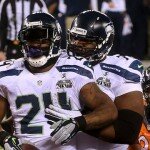Your draft plays a large factor in how well you will do this coming fantasy football season. In Part 1, I mentioned how to evaluate players and rank them based on their physical condition and team situation. However, once you have created your own rankings, you need to be fluid in your draft based on how it’s progressing.
Economics of Draft Value
Here is how you should reassess which players to target based on the economics of draft value. A player can be a great fantasy option, but you still shouldn’t draft him unless he’s worth his draft value. Draft value is often determined by two economic principles: scarcity and opportunity cost.
Scarcity
Scarcity is an economic principle which dictates that society has unlimited wants but limited resources to fulfill those wants. In this case, society is your fantasy football league, and those wants are talented players that will produce enough fantasy points for you to win the championship.
Simply put, everyone in your league wants to roster as many elite players as possible, but it’s impossible for everyone to draft his or her ideal team. Consequently, it’s important to prioritize which positions or players to target.
Whenever scarcity is mentioned in tandem with fantasy football, it often makes people think of elite RBs, as more and more NFL teams are moving to a committee approach for the ground game. However, I cannot stress enough how incorrect this notion is.
Scarcity completely depends on your league settings and league trends. While elite RBs are scarce in standard scoring leagues, scarcity depends on your league settings. There are so many customized leagues now that you should never just take other people’s rankings as your own, no matter how long they’ve played or how much of an “expert” they are touted to be.
For example, leagues that start three WRs require a change in draft strategy to account for the scarcity of the WR position. In such leagues, I would have no problem with anyone who chose to draft a player like A.J. Green or Demaryius Thomas over Marshawn Lynch or Eddie Lacy. In leagues that start two QBs or award six points for any TD, QBs would and should be drafted much earlier than in standard leagues.
The most common non-standard scoring setting is points per reception, or PPR. In PPR leagues that award partial or full points to receivers for a completed catch, WRs should be prioritized early on, arguably after the first four or five top RBs. Know which positions are valued in your league and the expected cost of each player, whether it’s draft round or auction dollars. And that brings me to opportunity cost.
Opportunity Cost
Opportunity cost is another economic principle that applies congruously to fantasy football. Basically, the opportunity cost of an item is the value of the best alternative. For our purposes, the cost of a player is the player that you could’ve drafted instead had you not drafted him.
Even if a player only costs a last-round draft pick or $0 in an auction, the cost of that player is still the value of the best alternative player you could have drafted instead. For example, you may have picked up Alshon Jeffery last year as a free agent for no cost, but you did pay for him. The price for Jeffery was whichever player you had to drop from your roster to add him.
Now, if that player you dropped was an injured Shane Vereen or Roddy White, you were probably pleased with your decision. But Jeffery didn’t really break out until Weeks 4 and 5, when he totaled over 300 yards and two TDs in those two weeks.
However, you could’ve dropped Zac Stacy for Jeffery, as Stacy didn’t do much until Week 6 or 7. You still made out fine in the end, but you definitely paid more than you thought to free up that roster spot for Jeffery.
In auction drafts, opportunity cost is very easy to measure. Here’s an example. Let’s say that you pay $50 for Calvin Johnson, and another team drafts Dez Bryant for $35. Both are elite WRs, and it’s arguable that Bryant could outperform Johnson in total fantasy points in 2014. If they end up performing similarly, Johnson’s cost was still only $50.
But his additional opportunity cost was also potentially losing out a player like Wes Welker, someone on whom you could’ve spent that extra $15 you would’ve had if you had drafted Bryant for $35 instead of Johnson.
In auction drafts, you absolutely should try to outbid other teams for players that you really want. Just make sure that the value of the player you’re getting is worth that extra $5 or $10. There are plenty of $2 players out there waiting to break out, and your budget will be short if you reach for big-name players who won’t materially outperform others at their position.
In snake drafts, opportunity cost is harder to measure but even more important to consider. For example, if you have an early pick in a deeper 14-team league, you’re guaranteed an elite RB like Jamaal Charles. However, who will you draft with your late second-round and early third-round picks?
Let’s assume you drafted second overall and take Charles. Then with your next two picks, do you take a RB2 and a WR like Reggie Bush and Vincent Jackson? Or should you draft two WRs like Randall Cobb and Antonio Brown?
That decision all depends on which players you think will be available to you later on in the draft. If your league favors RBs early, but you expect Ray Rice and Stevan Ridley to bounce back this year, draft Cobb and Brown. If your league favors WRs early, but you expect breakout seasons from Cordarrelle Patterson and Emmanuel Sanders, then grab Bush and Jackson.
The opportunity cost of your early round players fluctuates depending on your league’s size, scoring format and draft trends. Again, don’t be afraid to overpay for a player you believe in, but don’t overpay at a certain position if you think better value players will be there later in the draft.
Conclusion
Your player rankings are important, and you should put ample thought into projecting their performances and rearranging your rankings as things happen leading up to September. But your player rankings should only guide to how you draft and shouldn’t be commandments to follow blindly as you go down the list.
Realize that, although players may outperform others, the gap in points may not be material at the end of the season. Also take into account which players are likely to drop and outperform their ADPs. Assess which positions are scarce before and during the draft, and judge a player’s value by both his cost and his opportunity cost.
Feel free to reach out and contact me on social media for any questions you may have if you’re confused, and stay tuned for Part 3. In the next segment, I’ll address a couple more in-depth statistical methods of evaluating players.
Meng Song is a writer for www.RantSports.com. Follow him on Twitter @ms0ng, “like” him on Facebook or add him to your Google+ network.













